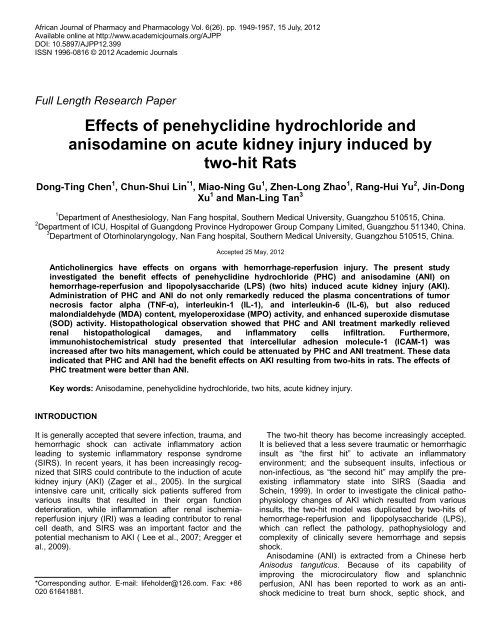Download Complete Issue (pdf 3800kb) - Academic Journals
Download Complete Issue (pdf 3800kb) - Academic Journals
Download Complete Issue (pdf 3800kb) - Academic Journals
You also want an ePaper? Increase the reach of your titles
YUMPU automatically turns print PDFs into web optimized ePapers that Google loves.
African Journal of Pharmacy and Pharmacology Vol. 6(26). pp. 1949-1957, 15 July, 2012<br />
Available online at http://www.academicjournals.org/AJPP<br />
DOI: 10.5897/AJPP12.399<br />
ISSN 1996-0816 © 2012 <strong>Academic</strong> <strong>Journals</strong><br />
Full Length Research Paper<br />
Effects of penehyclidine hydrochloride and<br />
anisodamine on acute kidney injury induced by<br />
two-hit Rats<br />
Dong-Ting Chen 1 , Chun-Shui Lin *1 , Miao-Ning Gu 1 , Zhen-Long Zhao 1 , Rang-Hui Yu 2 , Jin-Dong<br />
Xu 1 and Man-Ling Tan 3<br />
1 Department of Anesthesiology, Nan Fang hospital, Southern Medical University, Guangzhou 510515, China.<br />
2 Department of ICU, Hospital of Guangdong Province Hydropower Group Company Limited, Guangzhou 511340, China.<br />
3 Department of Otorhinolaryngology, Nan Fang hospital, Southern Medical University, Guangzhou 510515, China.<br />
Accepted 25 May, 2012<br />
Anticholinergics have effects on organs with hemorrhage-reperfusion injury. The present study<br />
investigated the benefit effects of penehyclidine hydrochloride (PHC) and anisodamine (ANI) on<br />
hemorrhage-reperfusion and lipopolysaccharide (LPS) (two hits) induced acute kidney injury (AKI).<br />
Administration of PHC and ANI do not only remarkedly reduced the plasma concentrations of tumor<br />
necrosis factor alpha (TNF-α), interleukin-1 (IL-1), and interleukin-6 (IL-6), but also reduced<br />
malondialdehyde (MDA) content, myeloperoxidase (MPO) activity, and enhanced superoxide dismutase<br />
(SOD) activity. Histopathological observation showed that PHC and ANI treatment markedly relieved<br />
renal histopathological damages, and inflammatory cells infiltration. Furthermore,<br />
immunohistochemistrical study presented that intercellular adhesion molecule-1 (ICAM-1) was<br />
increased after two hits management, which could be attenuated by PHC and ANI treatment. These data<br />
indicated that PHC and ANI had the benefit effects on AKI resulting from two-hits in rats. The effects of<br />
PHC treatment were better than ANI.<br />
Key words: Anisodamine, penehyclidine hydrochloride, two hits, acute kidney injury.<br />
INTRODUCTION<br />
It is generally accepted that severe infection, trauma, and<br />
hemorrhagic shock can activate inflammatory action<br />
leading to systemic inflammatory response syndrome<br />
(SIRS). In recent years, it has been increasingly recognized<br />
that SIRS could contribute to the induction of acute<br />
kidney injury (AKI) (Zager et al., 2005). In the surgical<br />
intensive care unit, critically sick patients suffered from<br />
various insults that resulted in their organ function<br />
deterioration, while inflammation after renal ischemiareperfusion<br />
injury (IRI) was a leading contributor to renal<br />
cell death, and SIRS was an important factor and the<br />
potential mechanism to AKI ( Lee et al., 2007; Aregger et<br />
al., 2009).<br />
*Corresponding author. E-mail: lifeholder@126.com. Fax: +86<br />
020 61641881.<br />
The two-hit theory has become increasingly accepted.<br />
It is believed that a less severe traumatic or hemorrhagic<br />
insult as “the first hit” to activate an inflammatory<br />
environment; and the subsequent insults, infectious or<br />
non-infectious, as “the second hit” may amplify the preexisting<br />
inflammatory state into SIRS (Saadia and<br />
Schein, 1999). In order to investigate the clinical pathophysiology<br />
changes of AKI which resulted from various<br />
insults, the two-hit model was duplicated by two-hits of<br />
hemorrhage-reperfusion and lipopolysaccharide (LPS),<br />
which can reflect the pathology, pathophysiology and<br />
complexity of clinically severe hemorrhage and sepsis<br />
shock.<br />
Anisodamine (ANI) is extracted from a Chinese herb<br />
Anisodus tanguticus. Because of its capability of<br />
improving the microcirculatory flow and splanchnic<br />
perfusion, ANI has been reported to work as an antishock<br />
medicine to treat burn shock, septic shock, and

















